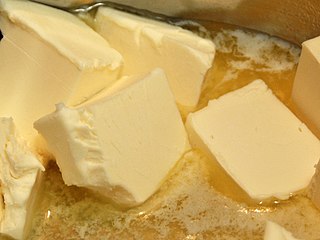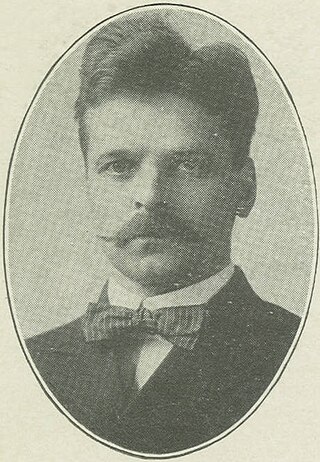
Butter is a dairy product made from the fat and protein components of churned cream. It is a semi-solid emulsion at room temperature, consisting of approximately 80% butterfat. It is used at room temperature as a spread, melted as a condiment, and used as a fat in baking, sauce-making, pan frying, and other cooking procedures.

Casein is a family of related phosphoproteins that are commonly found in mammalian milk, comprising about 80% of the proteins in cow's milk and between 20% and 60% of the proteins in human milk. Sheep and cow milk have a higher casein content than other types of milk with human milk having a particularly low casein content.

Buttermilk is a fermented dairy drink. Traditionally, it was the liquid left behind after churning butter out of cultured cream. As most modern butter in Western countries is not made with cultured cream but uncultured sweet cream, most modern buttermilk in Western countries is cultured separately. It is common in warm climates where unrefrigerated milk sours quickly.

Decantation is a process for the separation of mixtures of immiscible liquids or of a liquid and a solid mixture such as a suspension. The layer closer to the top of the container—the less dense of the two liquids, or the liquid from which the precipitate or sediment has settled out—is poured off, leaving denser liquid or the solid behind. The process typically is unable to remove all of the top layer, meaning the separation is incomplete or at least one of the two separated components is still contaminated by the other one.

Dairy cattle are cattle bred with the ability to produce large quantities of milk, from which dairy products are made. Dairy cattle generally are of the species Bos taurus.

The Babcock test is an inexpensive and practical procedure to determine the fat content of milk. It is named after its developer, Stephen M. Babcock (1843–1931), professor at the University of Wisconsin.

ε-Caprolactone or simply caprolactone is a lactone possessing a seven-membered ring. Its name is derived from caproic acid. This colorless liquid is miscible with most organic solvents and water. It was once produced on a large scale as a precursor to caprolactam.
George Malcolm Trout was an American dairy industry pioneer, writer, researcher, and professor emeritus in food science at Michigan State University. Trout is credited with finding the key to the creation of homogenized milk.
The American Dairy Science Association (ADSA) is a non-profit professional organization for the advancement of dairy science. ADSA is headquartered in Champaign, Illinois.
Κ-casein, or kappa casein, is a mammalian milk protein involved in several important physiological processes. Chymosin splits K-casein into an insoluble peptide and water-soluble glycomacropeptide (GMP). GMP is responsible for an increased efficiency of digestion, prevention of neonate hypersensitivity to ingested proteins, and inhibition of gastric pathogens. The human gene for κ-casein is CSN3.

Otto Frederick Hunziker was a pioneer in the American and international dairy industry, as both an educator and a technical innovator. Hunziker was born and raised in Switzerland, emigrated to the U.S., and studied at Cornell University. He started and developed the dairy program at Purdue University when such programs were at their infancy. At this same time, Hunziker was heavily involved with the development of the American Dairy Science Association (ADSA) and the standardization and improvement of many dairy tests and processes. Hunziker wrote several of the leading dairy processing texts, which continue to be cited. After leaving Purdue University, Hunziker managed research and operations at a large, national condensary, continued to drive ADSA's standardization and publishing efforts, represented the U.S. at international dairy congresses, and facilitated dairy industry improvements across the globe.

The fat content of milk is the proportion of milk, by weight, made up by butterfat. The fat content, particularly of cow's milk, is modified to make a variety of products. The fat content of milk is usually stated on the container, and the color of the label or milk bottle top varied to enable quick recognition.
Charles Roy Henderson was an American statistician and a pioneer in animal breeding — the application of quantitative methods for the genetic evaluation of domestic livestock. This is critically important because it allows farmers and geneticists to predict whether a crop or animal will have a desired trait, and to what extent the trait will be expressed. He developed mixed model equations to obtain best linear unbiased predictions of breeding values and, in general, any random effect. He invented three methods for the estimation of variance components in unbalanced settings of mixed models, and invented a method for constructing the inverse of Wright's numerator relationship matrix based on a simple list of pedigree information. He, with his Ph.D. student Shayle R. Searle, greatly extended the use of matrix notation in statistics. His methods are widely used by the domestic livestock industry throughout the world and are a cornerstone of linear model theory.
The Gerber method is a primary and historic chemical test to determine the fat content of substances, most commonly milk and cream. The Gerber method is the primary testing method in Europe and much of the world. The fairly similar Babcock test is used primarily in the United States, although the Gerber method also enjoys significant use in the U.S. as well.

The Latxa is a breed of domestic sheep native to the Basque Country of Spain. Mostly contained within the provinces of Biscay, Gipuzkoa and Navarre, Latxa are dairy sheep whose unpasteurized milk is used to produce Idiazábal and Roncal cheeses. There are two sub-types of the breed, a dark-faced and a blonde.

Thermization, also spelled thermisation, is a method of sanitizing raw milk with low heat. "Thermization is a generic description of a range of subpasteurization heat treatments that markedly reduce the number of spoilage bacteria in milk with minimal heat damage." The process is not used on other food products, and is similar to pasteurization but uses lower temperatures, allowing the milk product to retain more of its original taste. In Europe, there is a distinction between cheeses made of thermized milk and raw-milk cheeses. However, the United States' Food and Drug Administration (FDA) places the same regulations on all unpasteurized cheeses. As a result, cheeses from thermized milk must be aged for 60 days or more before being sold in the United States, the same restriction placed on raw-milk cheeses by the FDA.

Lore Alford Rogers was an American bacteriologist and dairy scientist. He is credited with discovering that butter made from pasteurized sweet cream remained fresher than that made from sour ripened cream, while suggesting that surplus milk could still be sold as concentrated sour milk products. He refined the steps for manufacture of high quality Swiss cheese and, new to the United States, production of Roquefort cheese. He was instrumental in finding ways to discourage fungal growth in sweetened condensed milk and preventing losses in evaporated milk from heat coagulation.
Delvotest is a broad spectrum microbial inhibition test used in dairy for testing antibiotic residue in milk and milk products. It is used to ensure milk safety and is produced by the global company DSM.
Carbonated milk or soda milk is a carbonated soft drink. It can be made from powdered milk or fresh milk, and often has added flavor. In addition to modified mouth feel, carbonated milk also has a longer shelf-life than similarly processed flat milk and a different flavor. It is sold by several companies and is most popular in Asia.
Louis Firth Nafis was an American entrepreneur and inventor, best known as the first manufacturer of the standard Babcock milk test bottle. He was born in Jersey City, New Jersey on November 1, 1884, and died on February 26, 1955, in Evanston, Illinois.













